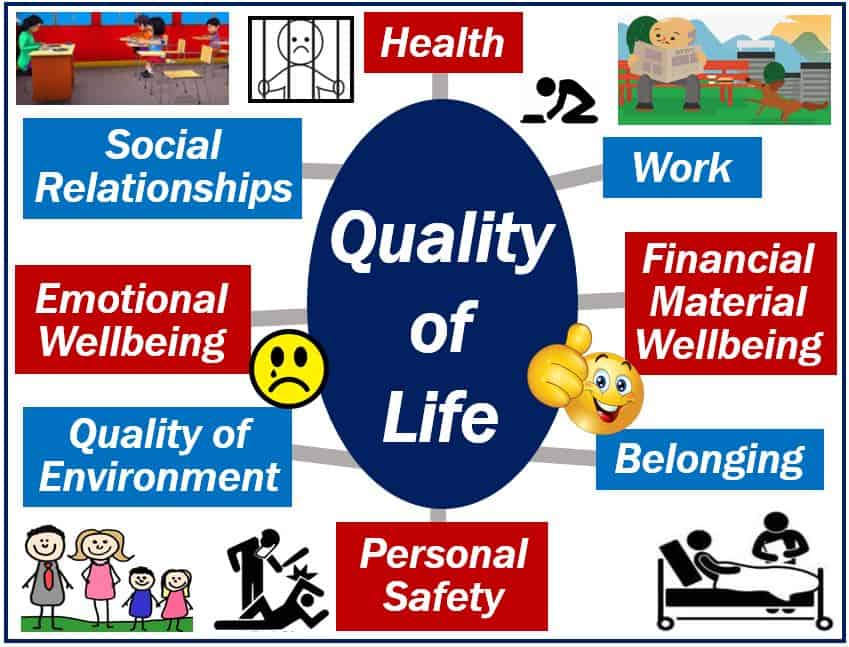Quality of Life refers to how well we live, i.e., the general well-being of people and societies. It is the standard of happiness, comfort, and health that a person or group of people experience. In other words, quality of life encompasses the overall enjoyment, satisfaction, and sense of fulfillment individuals or communities experience in their daily lives, factoring in aspects like physical health, education, employment, wealth, safety, and freedom.
It is an inherently ambiguous and subjective term. People who love sports may feel that their quality of life has suffered if local facilities close down. For a couch potato, on the other hand, the loss of sports facilities makes no difference.
Some people say quality of life is about wealth and owning things, while others may define it in terms of physical, mental, and emotional well-being.
Quality of life vs. standard of living
We can use the term in several different contexts, including politics, economic or international development, and healthcare.
We should not confuse the term with ‘standard of living,’ which focuses mainly on economic factors.

Standard of living
Standard of living refers to people’s level of prosperity (wealth), comfort, material possessions, and necessities.
When we calculate a society’s standard of living, we take into account factors such as employment, poverty rates, affordable housing, and GDP. GDP stands for Gross Domestic Product. We also take into account inflation, the cost of goods and services, infrastructure, and economic and political stability.
When calculating a person’s or society’s standard of living, we use things that we can quantify easily. GDP, prices, and employment/unemployment are factors we can measure.
Quality of life
The factors that make up quality of life are abstract, intangible, and subjective. The factors include the freedom to do things and freedom from bad things. Freedom of movement, of thought, and of religion, for example, are some of these factors. So are freedom from discrimination, slavery, and torture.
We also measure quality of life according to people’s rights, such as the right to education, human dignity, fair pay, and to have a family.
Environmental quality, including clean air and access to natural spaces, also significantly contributes to the perceived quality of life.
Most people would agree that we must consider levels of happiness when calculating quality of life. However, measuring or rating happiness is not easy. Happiness is a subjective thing.
We could, for example, send out a team of people to determine how often people smile. Researchers could then compare the same people today and in five years’ time. We could also compare how often people in the UK smile compared to Canadians.
Even with smiling, there are cultural factors that we would need to consider. In some countries, for example, telling jokes with a serious face makes it funnier. In other cultures, on the other hand, not smiling kills the joke.
Objective vs. subjective
Put simply, quality of life is subjective while standard of living is objective.
Medical treatment vs. quality of life
The instinct of most doctors and other healthcare professionals is to treat patients. In other words, to extend a person’s lifespan as long as possible.
However, especially with terminal illnesses, at which point should treatment stop? At which point should the quantity of life give way to quality of life? Especially if there is not much time left.
If a person has six months left to live, or seven months with treatment, which option is best?
Treatment and side-effects
Treatment often comes with side-effects such as pain, nausea, depression, diarrhea, and lethargy. If we chose to offer the terminal patient palliative/hospice care, would their last few months of life be better? Palliative care focuses on providing relief from pain and other unpleasant symptoms, as well as physical and mental stress.
This issue is going to get bigger as people in most advanced and emerging economies live longer and medical capabilities advance.
In a Psychology Today article, Ethan Remmel Ph.D. quotes Atul Gawande, who said:
“The soaring cost of health care is the greatest threat to the country’s long-term solvency, and the terminally ill account for a lot of it.”
“Twenty-five percent of all Medicare spending is for the five percent of patients who are in their final year of life, and most of that money goes for care in their last couple of months which is of little apparent benefit.”
Quality of life – happiness
The World Happiness Report ranks 156 countries according to how happy they are. It also ranks 117 countries according to the happiness of their immigrants.
The report ranks Finland as the happiest country in the world. The rest of the top ten, in order, are Norway, Denmark, Iceland, Switzerland, Netherlands, Canada, New Zealand, Sweden, and Australia. The United States and United Kingdom ranked 18th and 19th respectively.
The least happy country, according to the Report, is Burundi.
The World Happiness Report shows that standard of living and happiness are closely related. The happiest countries in the world also have the highest standards of living.
Video explanation
This video, from our YouTube partner channel – Marketing Business Network – explains what ‘Quality of Life’ is using simple and easy-to-understand language and examples.
